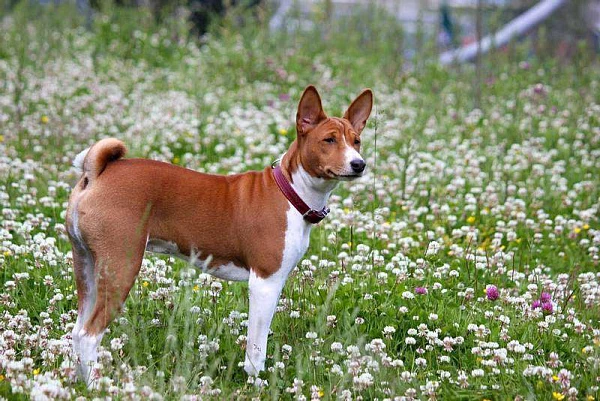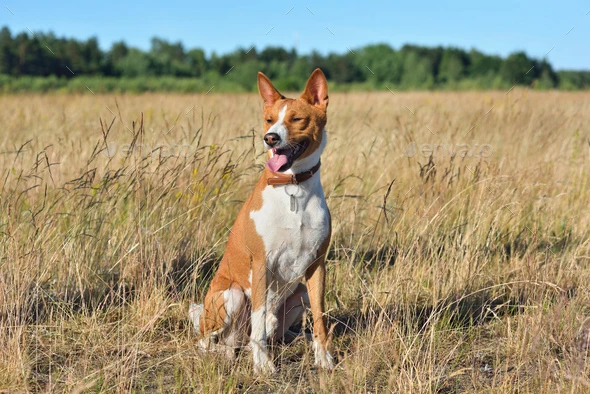On this page
About the Red and White Basenji Dog
The Red and White Basenji is a stunning variation of the Basenji breed, characterized by its vibrant red coat and contrasting white markings. Known as the "barkless dog", the Basenji originated in Central Africa and was initially bred as a hunting companion. This medium-sized breed is celebrated for its graceful build, intelligent demeanor, and independent personality.
Red and White Basenjis thrive in active households and are ideal for owners who enjoy an energetic and curious companion. Dr. Emily Sanders, DVM, explains that early training and consistent socialization are crucial to shaping their unique personality traits and ensuring they integrate well into family environments.
Want expert tips to care for your Basenji? Download the Dosty App today!
Is the Red and White Basenji a Unique Breed?
Yes, the Red and White Basenji is a distinctive coat variation within the Basenji breed. While Basenjis are known for their sleek and elegant appearance, the red and white color pattern adds a vibrant, eye-catching touch. Recognized by the American Kennel Club (AKC), this variation adheres to breed standards and shares the same physical and behavioral traits as other Basenjis.
Known for their cat-like independence, Red and White Basenjis are loyal yet reserved, often forming strong bonds with their owners. Dr. Olivia Hart, a canine behavior expert, highlights that their intelligence and agility make them well-suited for active families or individuals who can dedicate time to engaging activities.
For more tips visit our page Dosty.co.

Do Red and White Basenjis Have Specific Dietary Needs?
Yes, Red and White Basenjis benefit from a high-quality diet tailored to their active lifestyle. Puppies require protein-rich meals (22-28%) with essential nutrients like DHA for muscle and brain development. Adults thrive on balanced diets with 18-22% protein to maintain their lean physique and energy levels. Seniors benefit from joint-supportive nutrients such as glucosamine and omega-3 fatty acids.
Dr. Thomas Cooper, a veterinary nutritionist, advises including easily digestible proteins and healthy fats in their diet. Portion control is essential, as Basenjis are naturally lean but can gain weight if overfed or under-exercised.
Dietary Needs by Life Stage for Red and White Basenji
How Big Do Red and White Basenjis Get?
Red and White Basenjis are medium-sized dogs with an athletic build. Males typically weigh 22-26 pounds and stand 16-17 inches tall, while females weigh 20-24 pounds and are slightly shorter, standing 15-16 inches tall. Their sleek, muscular frame allows for speed and agility, traits that reflect their origins as hunting dogs.
Maintaining a healthy weight is critical for their long-term health. Regular exercise and portion-controlled meals help prevent obesity and related joint issues.
Keep your Basenji healthy with insights from the Dosty App!
Growth Chart for Male and Female Red and White Basenjis 📊
Monitoring your Red and White Basenji’s growth ensures they develop within healthy weight ranges and remain active and agile throughout their life.
Key Tips:
- 🏥 Schedule regular vet checkups to track their growth milestones.
- 🥗 Provide a diet tailored to their specific growth stages to support healthy development.
Need help training your Basenji? Get expert advice on the Dosty App.
Are Red and White Basenjis Easy to Groom?
Yes, Red and White Basenjis are low-maintenance when it comes to grooming. Their short, fine coat naturally repels dirt and requires minimal upkeep. Weekly brushing is sufficient to remove loose hair and keep their coat looking sleek. They shed lightly throughout the year, making them an excellent choice for owners seeking a clean and tidy home environment.
Bathing is needed only occasionally, as over-bathing can strip their coat of natural oils. Dr. Laura Bennett, a veterinary dermatologist, notes that Basenjis are prone to dry skin, so hypoallergenic shampoos are recommended. Regular nail trimming and ear cleaning should also be part of their grooming routine to ensure comfort and prevent infections.
Grooming Checklist for Red and White Basenjis
✅ Weekly brushing to maintain their sleek coat.
✅ Occasional baths with hypoallergenic shampoo.
✅ Regular ear cleaning to prevent wax buildup.
✅ Nail trimming every 3-4 weeks.
For more tips visit our page Dosty.co.
Do Red and White Basenjis Enjoy Playtime?
Absolutely! Red and White Basenjis are energetic and playful, requiring daily activities to stay mentally and physically engaged. Without sufficient stimulation, they may develop destructive behaviors like chewing or digging. Structured playtime and interactive toys help channel their energy positively.
Top Activities for Red and White Basenjis:
- 🐕 Fetch: Builds agility and endurance.
- 🧩 Puzzle toys: Challenges their intelligence and problem-solving skills.
- 🦴 Tug-of-war: Strengthens muscles and creates bonding opportunities.
- 🏃 Short runs or hikes: Satisfies their natural hunting instincts.
Incorporating play into their daily routine ensures they remain happy and well-balanced.

Are Red and White Basenjis Good for Families?
Yes, Red and White Basenjis make excellent family pets, especially for active households. They are affectionate with their owners and playful with children, though their independent nature means they may require patience during training. Supervision is recommended when they are around smaller children to avoid accidental knocks or bumps.
Dr. Ethan Miles, an animal behaviorist, emphasizes the importance of early socialization to ensure Red and White Basenjis are confident and well-mannered. Consistent training methods and positive reinforcement work best to guide their behavior and strengthen their bond with family members.
Comparison Table: Red and White vs. Brindle Basenjis
What Health Issues Are Common in Red and White Basenjis?
Like other Basenjis, the red and white variety is prone to certain genetic and breed-specific health issues. Regular veterinary care and a proactive approach to their well-being can help manage these risks effectively.
Common Health Concerns for Red and White Basenjis:
- 🐾 Fanconi Syndrome: A kidney condition that affects their ability to absorb nutrients.
- 🦵 Hip Dysplasia: Can impact mobility in later years.
- 👁️ Progressive Retinal Atrophy (PRA): Leads to gradual vision loss.
Dr. Benjamin Cole recommends regular health screenings and a balanced diet to support their long-term health. Keeping them active and at a healthy weight also reduces the likelihood of joint and mobility issues.
FAQs About Red and White Basenjis
1. Are they good for apartments?
Yes, provided they get regular exercise and mental stimulation.
2. How much exercise do they need?
At least 60 minutes daily of physical activity.
3. Do they shed a lot?
No, they are light shedders and easy to groom.
4. What’s their average lifespan?
Red and White Basenjis live 12-16 years with proper care.
Conclusion: Why the Red and White Basenji Is a Great Choice
The Red and White Basenji is a loyal, intelligent, and energetic breed that brings joy and adventure to any household. Their unique coat color, combined with their affectionate and playful personality, makes them a standout choice for active families or individuals seeking a spirited companion. With proper care, training, and attention, Basenjis thrive as loving and devoted pets.
Download the Dosty App now and start caring for your Basenji today!

